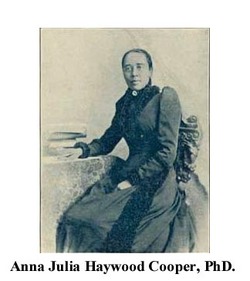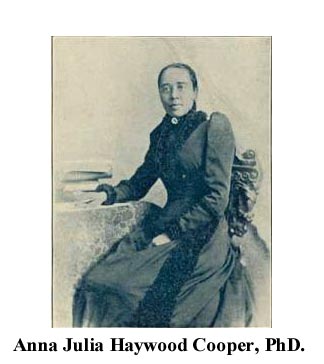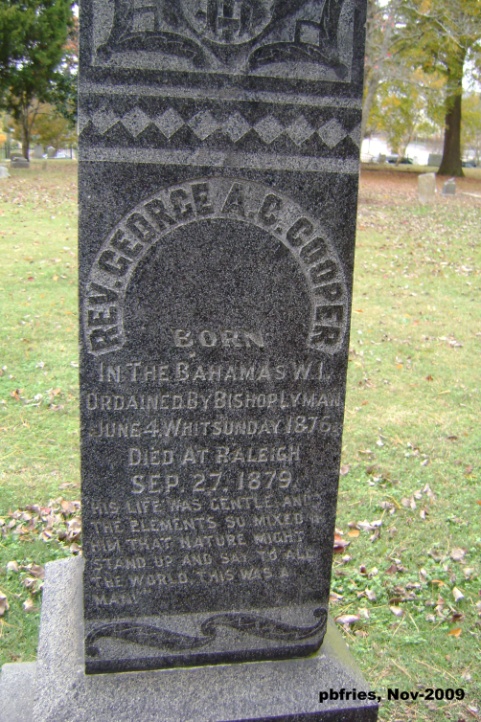George A. C. Cooper was born into slavery in 1847 in the Bahamas, West Indies.
It is not known how or when George Cooper came to the mainland in the United States, but it is known he made his way to Raleigh, NC by 1870 where he was enrolled in St. Augustine's Normal School and Collegiate Institute, a school created by Episcopal funds to provide educational opportunity for newly freed blacks, where the former slave was studying to become a minister.
Some sources report George was a teacher of Greek studies while at St. Augustines, and it was here that he met Annie Julia Haywood, daughter of Hannah Stanley Haywood. Though her mother never spoke of it, Annie, who was light skinned, presumed herself to be the offspring of Hannah and her slave master, prominent attorney George Washington Haywood, with whom neither she nor her mother maintained any ties. Most historians agree with this assumption. Haywood is widely believed by historians to be the biological father of Stanley's seven daughters. Anna also had two older brothers named Andrew J. Haywood and Rufus Haywood.
Her father, George Washington Haywood (1802-1890), was born in Edgecombe County and rose to prominence in Raleigh where he was state attorney for Wake County. He also owned a plantation in Alabama in partnership with his brother, John Steele Haywood, and it was there he removed to after the Civil War and died there in 1890. Although married, and the father of 2 known children, his wife died young and it is believed that is when he formed a liason with his slave, Hannah Stanley Haywood. Whether this relationship was welcomed by Hannah, who was 20 years his junior, is not known.
George A.C. Cooper was ordained an Episcopal Minister on June 4, 1876 by Bishop Theodore Benedict Lyman in Raleigh. A year later, in June 1877, he married Anna Julia Haywood. He was about 30 at the nuptials, and she 18.
The marriage was short-lived as George died two years later on September 28, 1879 at age 32.
His young widow never remarried and lived to the age of 105, achieving great success as an educator, author, poet, school administrator and an early and vocal advocate of equal rights for blacks and women. She was the author of the essays in "A Voice from the South", which touched on a variety of topics, from racism and the socioeconomic realities of black families, to the administration of the Episcopal Church. Among her many accomplishments, she is known for her famous quote: "The cause of freedom is not the cause of a race or a sect, a party or a class – it is the cause of humankind, the very birthright of humanity." The quote today is included on every U.S. passport.
George is buried in City Cemetery in Raleigh, where the remains of his wife were laid to rest 85 years later. Anna Julia Haywood Cooper paid for the handsome polished marble grey obelisk that marks his grave. She also paid for a stained glass window to be placed in St. Augustine's now Historic Chapel (built ca 1895), in honor of her husband.
George A. C. Cooper was born into slavery in 1847 in the Bahamas, West Indies.
It is not known how or when George Cooper came to the mainland in the United States, but it is known he made his way to Raleigh, NC by 1870 where he was enrolled in St. Augustine's Normal School and Collegiate Institute, a school created by Episcopal funds to provide educational opportunity for newly freed blacks, where the former slave was studying to become a minister.
Some sources report George was a teacher of Greek studies while at St. Augustines, and it was here that he met Annie Julia Haywood, daughter of Hannah Stanley Haywood. Though her mother never spoke of it, Annie, who was light skinned, presumed herself to be the offspring of Hannah and her slave master, prominent attorney George Washington Haywood, with whom neither she nor her mother maintained any ties. Most historians agree with this assumption. Haywood is widely believed by historians to be the biological father of Stanley's seven daughters. Anna also had two older brothers named Andrew J. Haywood and Rufus Haywood.
Her father, George Washington Haywood (1802-1890), was born in Edgecombe County and rose to prominence in Raleigh where he was state attorney for Wake County. He also owned a plantation in Alabama in partnership with his brother, John Steele Haywood, and it was there he removed to after the Civil War and died there in 1890. Although married, and the father of 2 known children, his wife died young and it is believed that is when he formed a liason with his slave, Hannah Stanley Haywood. Whether this relationship was welcomed by Hannah, who was 20 years his junior, is not known.
George A.C. Cooper was ordained an Episcopal Minister on June 4, 1876 by Bishop Theodore Benedict Lyman in Raleigh. A year later, in June 1877, he married Anna Julia Haywood. He was about 30 at the nuptials, and she 18.
The marriage was short-lived as George died two years later on September 28, 1879 at age 32.
His young widow never remarried and lived to the age of 105, achieving great success as an educator, author, poet, school administrator and an early and vocal advocate of equal rights for blacks and women. She was the author of the essays in "A Voice from the South", which touched on a variety of topics, from racism and the socioeconomic realities of black families, to the administration of the Episcopal Church. Among her many accomplishments, she is known for her famous quote: "The cause of freedom is not the cause of a race or a sect, a party or a class – it is the cause of humankind, the very birthright of humanity." The quote today is included on every U.S. passport.
George is buried in City Cemetery in Raleigh, where the remains of his wife were laid to rest 85 years later. Anna Julia Haywood Cooper paid for the handsome polished marble grey obelisk that marks his grave. She also paid for a stained glass window to be placed in St. Augustine's now Historic Chapel (built ca 1895), in honor of her husband.
Family Members
Advertisement
Explore more
Sponsored by Ancestry
Advertisement






